VPLS Service Configuration Commands
Page 504 7750 SR OS Services Guide
VPLS Filter and QoS Policy Commands
egress
Syntax egress
Context config>service>vpls>sap
Description This command enables the context to configure egress SAP Quality of Service (QoS) policies and
filter policies.
If no sap-egress QoS policy is defined, the system default sap-egress QoS policy is used for egress
processing. If no egress filter is defined, no filtering is performed.
ingress
Syntax ingress
Context config>service>vpls>sap
Description This command enables the context to configure ingress SAP Quality of Service (QoS) policies and
filter policies.
If no sap-ingress QoS policy is defined, the system default sap-ingress QoS policy is used for ingress
processing. If no ingress filter is defined, no filtering is performed.
agg-rate-limit
Syntax agg-rate-limit agg-rate
no agg-rate-limit
Context config>service>vpls>sap>egress
Description This command defines a maximum total rate for all egress queues on a service SAP or multi-service
site. The agg-rate-limit command is mutually exclusive with the egress scheduler policy. When an
egress scheduler policy is defined, the agg-rate-limit command will fail. If the agg-rate-limit
command is specified, an attempt to bind a scheduler-policy to the SAP or multi-service site will fail.
A multi-service site must have a port scope defined that ensures all queues associated with the site are
on the same port or channel. If the scope is not set to a port, the agg-rate-limit command will fail.
Once an agg-rate-limit has been assigned to a multi-service site, the scope cannot be changed to card
level.
A port scheduler policy must be applied on the egress port or channel the SAP or multi-service site
are bound to in order for the defined agg-rate-limit to take effect. The egress port scheduler enforces
the aggregate queue rate as it distributes its bandwidth at the various port priority levels. The port
scheduler stops offering bandwidth to member queues once it has detected that the aggregate rate
limit has been reached.
If a port scheduler is not defined on the egress port, the queues are allowed to operate based on their
own bandwidth parameters.

